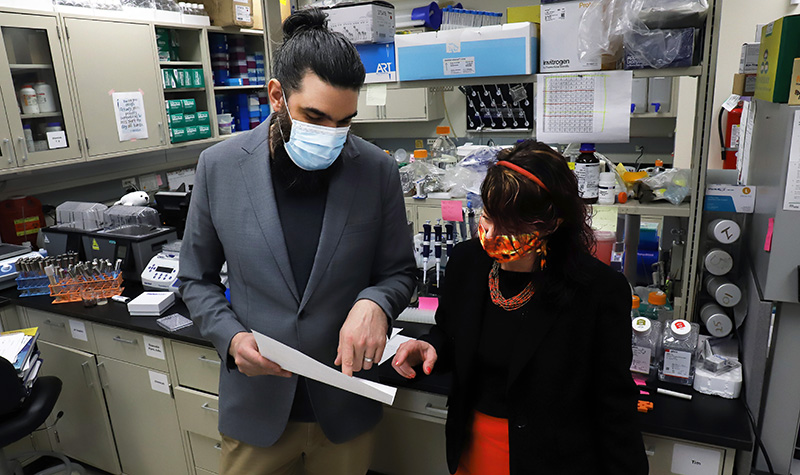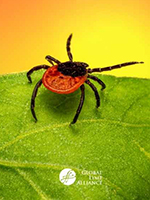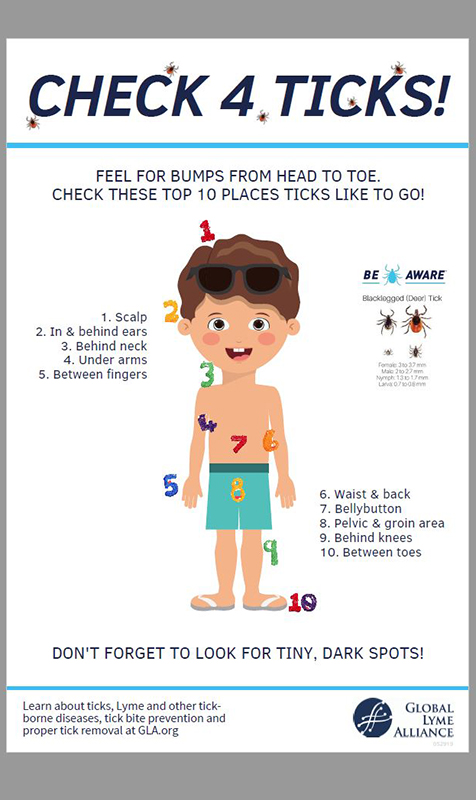Connecting the dots between Lyme disease and COVID
Global Lyme Alliance research at UND could provide leads for COVID, other diseases

Is there a connection between why some people with Lyme disease and some with COVID-19 experience long-term effects to their central nervous systems?

Known as neurological Lyme disease (NLD), the condition affects about 10% to 20% of those who contract the infection after being bitten by black-legged deer ticks. Rather than recovering from the disease, they continue to experience such symptoms as severe headaches, brain fog, facial paralysis, sensitivity to light and memory loss.
What’s learned about the similarities between the long-lasting effects of Lyme disease and COVID could apply to other infectious diseases as well.
UND researchers Catherine Brissette, associate professor of biomedical sciences in the School of Medicine & Health Sciences, and Timothy Casselli, research assistant professor, are developing a model with funding from the Global Lyme Alliance they believe can help answer these questions.
“There’s a lot of interest in this now because of long COVID,” Brissette noted. “But there are probably other infections in which you have a post-infectious syndrome where people have brain fog and fatigue and a constellation of symptoms of not feeling like they’re back 100%.
“We hope our research will help add some clues as to why people have those kinds of things,” she added. “I actually think it’s broader than Lyme disease.”

COVID connections
The similarities between NLD and “long COVID-19” patients – also called “long haulers” – who suffer damage to their lungs, hearts and brains months after contracting the virus was discussed in a November 2020 article by Mayla Hsu, GLA’s former director of research and science.
“The science underlying both illnesses is still being learned,” she wrote. “And it’s increasingly recognized that a subset of Covid-19 patients, like Lyme disease patients, suffers long-term debilitating symptoms that may take months or even longer to lift.”
The Borrelia burgdorferi bacteria that causes Lyme disease is transferred from ticks to humans or other host animals. First discovered in the 1970s on the East Coast, the disease has spread throughout the United States and the world with 476,000 known cases in this country annually.
The model under development at UND uses mice to understand how the bacteria interacts with the host to create different manifestations.
“This is to develop an understanding of the basic mechanisms on how an infection that doesn’t appear to directly get into the brain can still have effects on the brain,” Casselli explained. “We don’t have a good understanding of how that happens with Lyme disease because up until this point, we haven’t had a good model for testing.”

Understanding what causes neurological problems in people who don’t have a brain infection is one aspect of the research that could be useful in developing new treatments.
“In the course of our research, we might find clues,” Brissette said. “We might find biomarkers – molecules that predict how someone might have problems down the line. In the long term, this research could lead to differences in treatment and perhaps diagnostics as well.”
More effective treatments
The project’s long-term goal is to use the mouse model to identify the disease-carrying bacteria, the host and the environmental factors triggering central nervous system involvement, potentially leading to new and more effective treatments for NLD.

“Our research has shown that the mouse is indeed a good model to look at inflammation in the central nervous system,” Brissette said. “The mouse model of Lyme disease has been instrumental in the fundamental understanding of how the bacteria interact with the host and how the disease manifests itself. It’s really well established for looking at things like arthritis.”
Casselli said developing a better understanding of the effects of Lyme disease has implications for the treatment of neurological complications arising from diseases in which the brain isn’t directly affected.

“If it turns out that neurological complications are an indirect effect of an infection that’s not in the brain, it would be treated very differently from an infection where you knew the bacteria was getting into the brain,” he said. “We need to understand the pathways that lead to these clinical complications so we can take the appropriate treatment measures against them.”
Brissette said it’s a matter of using the research results to target treatments to address specific conditions.
“I think about precision medicine and the strides we’ve made in treating cancer,” she explained. “We now know which person is the best candidate for a particular antibody treatment because we’ve identified a biomarker showing who’s likely to benefit from it.
“Ideally, with neurological Lyme disease, the golden ticket would be if we could find markers showing which person is a great candidate for treatment and has the best chance for a good outcome.”
Lyme disease awareness
GLA is a nonprofit organization that works to conquer Lyme and other tick-borne diseases through research education, awareness and patient services. With May being Lyme Disease Awareness Month, GLA is letting the public know of measures to prevent Lyme disease by being tick aware.
Brissette, who’s a member of GLA’s scientific advisory board and reviews research proposals for the organization, said it’s an important source of funding for Lyme disease research.
“Federal funding is difficult to achieve, and there aren’t a lot of alternative sources for research funding,” she said. “It’s really great when there are nonprofits that target certain diseases and provide funds to basic researchers.”
Brissette listed other advantages of GLA membership.
“All the projects they fund get peer-reviewed by other scientists who study Lyme disease,” she said. “It provides us with an opportunity to get new data that we can then use on other grant applications.
“They also have research conferences they put on where they invite people who are awardees to come share their findings,” Brissette continued. “That’s always nice because then you get to interact with other people in the field, make new connections and get new ideas.”



